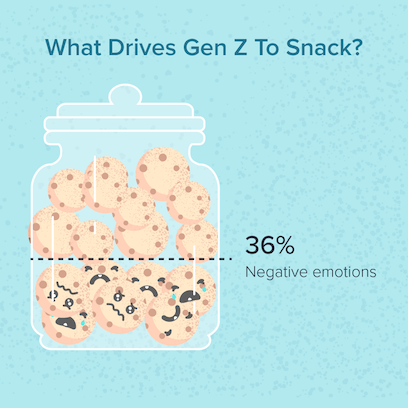Generation Z is the generation with the largest spending power of an estimated $143 billion annually. Gen Z is transforming most industries, among them the snacking industry. In order to learn more about their snacking habits, we conducted a survey among 2,500 Gen Z-ers ages 13-24 years in the U.S.
Recent studies show that in the U.S., 58% of Gen Z adults report deep unhappiness with their eating habits. By the same token, other studies show that Gen Z consumers are more health-conscious than their predecessors, the Millennials. Recognizing the diversity of Generation Z, we segmented our survey respondents by the various reasons why they snack.
According to our study, 36% of Generation Z are “emotional snackers”, reporting that negative emotions such as stress, anxiety, and sadness are drivers that lead them to snack.

So who are these Gen Z emotional snackers? According to our survey:
- Emotional snackers are frequent snackers. Gen Z snackers who are driven by negative emotions are almost 2x more likely to snack three or more times a day, compared to snackers who do not snack for these reasons. They are also 80% more likely to snack on snack cakes, 65% more likely to snack on chocolate, and 51% more likely to snack on candy.
- Twiddling thumbs? Emotional snackers would rather eat. Emotional eaters who snack out of sadness, anxiety, and stress, are also more likely to snack when they don’t feel engaged or interested. Compared to non-emotional snackers, emotional snackers are almost 2x as likely to snack out of boredom.
- Emotional snackers prefer that a snack be accessible rather than healthy. Taste, followed by price, are the most important factors in a snack, according to emotional and non-emotional snackers alike. However, emotional snackers differed with non-emotional snackers on the importance of health and accessibility factors of a snack. For emotional snackers, the accessibility of a snack (45%) is much more important than its health (25%), while for non-emotional snackers health and accessibility factors are of similar importance (29%).
- Females ages 13-15 have the highest rate of emotional snacking. When analyzing across both respondents’ gender and ages, we found that emotional snacking is most common among females in our youngest age group, with 44% of all females ages 13-15 years reporting that they emotionally snack.
- With age, less females and more males emotionally snack. Overall, female Gen Z-ers are 25% more likely than males to be emotional snackers. However, when segmenting by age group, certain trends are apparent. While 44% of females ages 13-15-years-old emotionally snack, this rate drops to 34% among 22-24-year-old females. For males, only 27% of 13-15-year-olds emotionally snack, however this rate increases to 34% among 22-24-year-olds.
- Emotional snackers shop more, exercise less. Compared to non-emotional snackers, emotional snackers are 38% more likely to shop on a regular basis. They’re also 37% less likely to exercise.
- Sour Patch Kids is the favorite candy brand among emotional snackers. Emotional snackers are 50% more likely to snack on candy and have different brand preferences compared to non-emotional snackers. While Sour Patch Kids are the #1 preferred brand by emotional snackers, non-emotional snackers chose Starburst as their favorite brand. Although both brands are very sweet, Sour Patch Kids have a distinct mouth-puckering sour flavor, leading us to theorize that emotional snackers may pursue more extreme tastes.
Notable demographic and behavioral patterns exist among emotional snackers. Gen Z’s emotional snackers are overwhelmingly younger females who are frequent snackers that prefer intense flavors and are quick to snack for reasons such as boredom and accessibility, instead of for health considerations.
Successful snacking brands need to recognize that Gen Z is widely diverse, and that snacking motivations and behaviors vary greatly by individual. Segmenting Gen Z snackers according to underlying motivations (negative emotions, satisfying hunger, etc.) gives brands a true understanding of their target audience, and enables highly effective growth strategies such as personalization.

